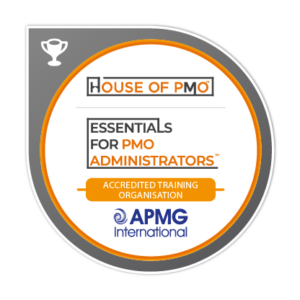
The PMO Competency Framework by the House of PMO has been created to provide a standard and a toolset to allow PMO professionals to understand, assess and develop the skills, behaviours and experience to achieve their PMO goals and career potential. We’re going to be taking a closer look at what a competency framework is, why those in the PMO should be interested, and how we can use the PMO Competency Framework to fill our skills gap.
What is a Competency Framework?
The PMO Competency Framework is is a collection of competences required across the different roles in the PMO profession.
It details the required competences and levels of proficiency needed for each of those roles, encapsulated in role profiles.
The four role profiles are PMO Administrator, PMO Analyst, PMO Manager and PMO Director.
The framework has been developed by PMO Professionals, for PMO Professionals, and was initiated to address the needs of many PMO professionals who have felt that, for many years, there was no competency framework and assessment available that specifically focused on PMO roles.
Why Should Those in the PMO be Interested in a Competency Framework?
The framework provides professionals with the means to assess their independent competence against a professional standard, breaking down the four parts of the assessment:
- Select – Choose to use a role profile as a starting point for your assessment or carry out the full assessment.
- Reflect – Take time to reflect on your career to date, thinking about the different experiences you have.
- Assess – Set aside quiet time to work through the assessment, the first time should take a few hours.
- Evidence – Gathering evidence to support your assessment is required, and this is where most of your time for the assessment is taken up.
When you evaluate your PMO skills against the framework, you’ll find that in some areas of competency, you’re doing well, or are particularly competent. However, there may be some areas in which you’re less competent.
For some of us, particular skills are not required of us within the role we are currently performing. Whilst we may not be currently expected to demonstrate competency in these skills, the PMO Competency Framework provides us with the tools and education to be informed about the gaps in our skills and enables us to make decisions about addressing those gaps.
Filling your Skills Gap
Based on your personal assessment against the framework, the breadth of your skills gap may vary, and the experience required may also differ – it may be practical or knowledge-based, and it may require different levels of investment.
Let’s look at some examples.
One of the key competencies in the framework is project delivery, and the many aspects of this, such as risk management, stakeholder engagement, and reporting. For some professionals, particularly at a Foundation level, there may be a large gap in knowledge, which may be filled by a qualification that covers a broad, high-level understanding of the PMO, for example, the P3O® Certifications.
Alternatively, there may be one aspect of a competency that needs revisiting, or tweaking in order to fill the skills gap. This could be enhancing your reporting skills, which may require a lower level of investment, in the form of a webinar, or communicating with others in your team.
For more complex skills gaps, more investment may be needed. For example, you may not have to utilise your benefits management competency skills as part of your role, but this could be something you were looking to address.
The first step would be to assess your competency against the framework – this way you can see where you are currently working at, what you need to achieve to reach higher levels of competency, and examples of how you could gain experience in this.
Developing this competency may take some time. Your initial investment may start with reading an article on benefits management, investing in a textbook, or discussing with others within your team or organisation.
Once you have a foundation established, you may want to take a further step in development – a short online course about producing Gantt charts or more complex spreadsheets, for example through LinkedIn Learning or another online learning resource.
Once you have gained some more experience, and further advanced your skills against the competency framework, you may want to look at longer-term investment in the benefits
management competency. For example, you may look to move beyond the Intermediate level which responsibilities may include validating project data, or providing support to those applying the benefits management framework in your organisation.
The next step may be advancing to facilitating project workshops surrounding benefits management, overseeing the delivery of PMO services to the project, and recommending amendments to project schedules to optimise benefits realisation.
This is the beauty of the PMO Competency Framework – you are able to devise your own plan for development, aided by the framework which can give you practical advice, act as a point of reference, and help you fill your PMO skills gap.
You can find out more about the House of PMO and the PMO Competency Framework at their website
The P3O® courses on this page are offered by PMO Learning. P3O® is a [registered] trade mark of AXELOS Limited. All rights reserved. P3O® is a registered trade mark of AXELOS Limited, used under permission of AXELOS Limited. The Swirl logo™ is a trade mark of AXELOS Limited, used under permission of AXELOS Limited. All rights reserved.
Enjoying Our Blog?
Sign up and receive all our articles (we’ll send you an update once a week!) plus special offers and events:
This post contains affiliate ad links.















Comments